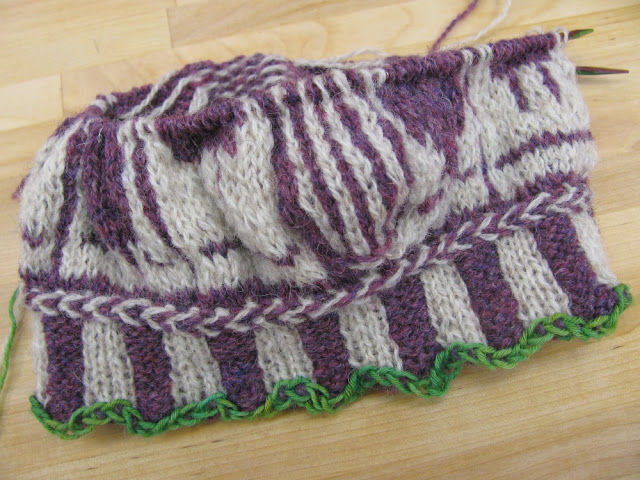After the provisional cast on, corrugated ribbing and a vikkel braid we're onto the sheep!
 |
| photo credit: Kate Davies |
But first we need to cast on more stitches... a backward loop cast on. Probably the simplest cast on and shown here. Remember and use different stitch markers to mark the spout and the handle.
The sheep will be done as stranded colourwork rather than as intarsia (which is used for block motifs... you can read our beginners guide about intarsia here)
There is nice article about stranded colourwork here at Let Me Explaiknit.
Basically you're using two colours on each row and stranding the unused colour behind the colour in use. Stranding just means letting the unused yarn 'stretch' or float across the back of the colour that is in use, so that you can knit with it later along the row.
There are different ways to do this... holding both colours in one hand and picking up and dropping the yarns as required or using both your hands - one to hold each colour. You then pick one colour (Continental style) and throw the other (English/US style).
There is an excellent video here from Knit Picks which shows this two hand technique as well as how to deal with your floats.
In the Sheep Carousel pattern, Kate suggests that there is no need to weave in or wrap your floats if your tension is consistent. Weaving/wrapping you floats is explained in the Knit Picks video. They suggest you do it when you have to strand your yarn over 5 or more stitches. Other advice puts this number higher and lower! Let Me Explaiknit also highlights that the type of yarn and how knitted items are to be used can also determine how you deal with floats.
For example if you are using a cotton or blend or even a superwash wool then the yarn is unlikely to 'stick' together as well as a pure untreated wool. Also if its for a garment, especially for a child, then long floats might get caught.
(Fiona) So! This is my first time doing stranded colourwork. Having watched the Knit Picks video I felt ready to try the two handed method. I had already used the Continental 'picking' style whilst knitting some of my Color Affection, so I felt comfortable with that.
Also holding each yarn in a different hand stopped the balls tangling.
I was very unsure what to do with my floats though! Despite Kate's assurances that as long the tension was consistent there was no need to weave them, in I wasn't reassured. I wasn't sure my tension was consistent, especially in my left hand (picking) and I'm a loose knitter anyway. So I've done both (which goes against my nature as I do like to be consistent!)
 |
| long floats v's wraps |
I have now decided to go with the no weaving/wrapping and just carry my floats freely. I like the look of the long strands better than the wrapped ones and the purple did show through a few times when wrapped by the white. I'm using non superwash Shetland wool that will surely 'stick' together nicely and its a TEA COSY! It is not getting pulled on and off a small child's head.... hopefully.
 |
| my 'steek' stitches |
 |
| something missing? |
So I was happily knitting along, silently debating wrapping v's not wrapping, loving the feel of the Shetland wool, marvelling at my stranded colourwork prowess and congratulating myself at remembering to cast off the spout steek on row 15 (this is marked on the chart - you may like to highlight it further).
And then... I realised I was so consumed with bringing in the 'higher' sheep that I completely missed the 'lower' sheep face!!!! There was no easy way to fix it other than knit backwards to get back to row 12.
So, my hot tip is... pay attention the chart!
(Although like most things in this pattern knitting, backwards in two colours wasn't so difficult after all.)
Remember to post your photos to our Facebook wall and Ravelry group (there are a few photos already there).

Looking good Fiona!
ReplyDelete